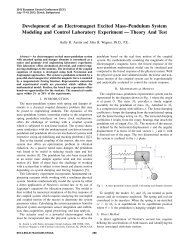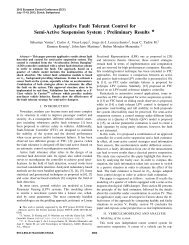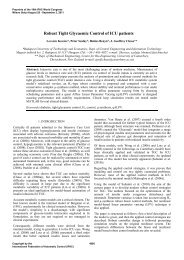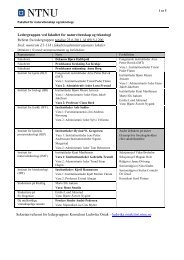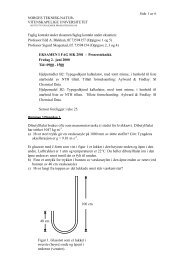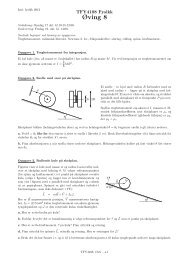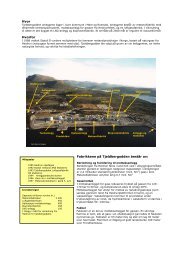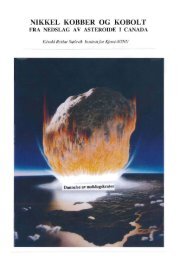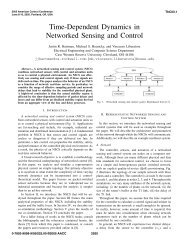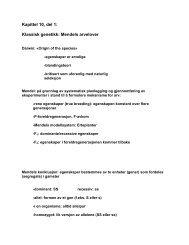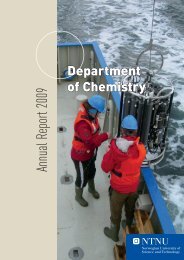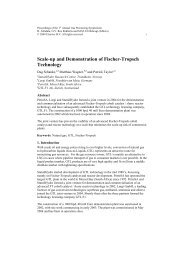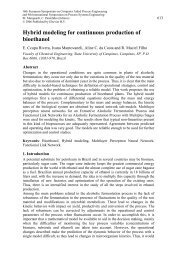Separation of Asphaltenes and Lube Oil from Petroleum Residuum ...
Separation of Asphaltenes and Lube Oil from Petroleum Residuum ...
Separation of Asphaltenes and Lube Oil from Petroleum Residuum ...
You also want an ePaper? Increase the reach of your titles
YUMPU automatically turns print PDFs into web optimized ePapers that Google loves.
The characterization <strong>of</strong> the asphaltene component in the process simulator was done<br />
based on the molecular structure <strong>of</strong> the low molar mass asphaltene <strong>of</strong> Figure 1B. The<br />
molecule was characterized with UNIFAC group contribution method.<br />
The lube oil free <strong>of</strong> asphaltenes is consisted <strong>of</strong> a mixture <strong>of</strong> saturates, aromatics <strong>and</strong><br />
resins. As a representative way, it was selected the paraffin n-eicosane (C20H42) as the<br />
representative component for oil in the process simulator.<br />
The thermodynamic equilibrium model used in the simulation was PSRK with<br />
Holderbaum-Gemehling mixing rules. The binary interaction parameters kij were well<br />
predicted using UNIFAC for all pairs <strong>of</strong> components.<br />
The ternary diagrams generated with Aspen Plus for the system asphaltenes-oil-pentane<br />
are shown in Figure 2.<br />
OIL<br />
0.95 0.9 0.85 0.8 0.75 0.7 0.65 0.6 0.55 0.5 0.45 0.4 0.35 0.3 0.25 0.2 0.15 0.1 0.05<br />
N-PEN-01<br />
0.95 0.9 0.85 0.8 0.75 0.7 0.65 0.6 0.55 0.5 0.45 0.4 0.35 0.3 0.25 0.2 0.15 0.1 0.05<br />
0.05 0.1 0.15 0.2 0.25 0.3 0.35 0.4 0.45 0.5 0.55 0.6 0.65 0.7 0.75 0.8 0.85 0.9 0.95<br />
ASPHALT<br />
A<br />
OIL<br />
0.95 0.9 0.85 0.8 0.75 0.7 0.65 0.6 0.55 0.5 0.45 0.4 0.35 0.3 0.25 0.2 0.15 0.1 0.05<br />
N-PEN-01<br />
0.95 0.9 0.85 0.8 0.75 0.7 0.65 0.6 0.55 0.5 0.45 0.4 0.35 0.3 0.25 0.2 0.15 0.1 0.05<br />
0.05 0.1 0.15 0.2 0.25 0.3 0.35 0.4 0.45 0.5 0.55 0.6 0.65 0.7 0.75 0.8 0.85 0.9 0.95<br />
ASPHALT<br />
B<br />
OIL<br />
0.95 0.9 0.85 0.8 0.75 0.7 0.65 0.6 0.55 0.5 0.45 0.4 0.35 0.3 0.25 0.2 0.15 0.1 0.05<br />
N-PEN-01<br />
0.95 0.9 0.85 0.8 0.75 0.7 0.65 0.6 0.55 0.5 0.45 0.4 0.35 0.3 0.25 0.2 0.15 0.1 0.05<br />
0.05 0.1 0.15 0.2 0.25 0.3 0.35 0.4 0.45 0.5 0.55 0.6 0.65 0.7 0.75 0.8 0.85 0.9 0.95<br />
AS PHALT<br />
Figure 2– Ternary diagram <strong>of</strong> the asphalt-oil-pentane mixture at 10 bar, 33 bar <strong>and</strong> 40<br />
bar.<br />
The principles governing the phase behavior shown in these diagrams are similar to<br />
those described by Wilson et al. (1936). At 10 bar (subcritical conditions), pentane is<br />
almost entirely miscible with the oil, the oil is almost entirely miscible with the asphalt<br />
too, but the pentane is only partially miscible with the asphalt, therefore the asphalt falls<br />
out <strong>of</strong> the solution. This represents the first step <strong>of</strong> the lube oil refining process.<br />
Figure 2B shows that for a pressure slightly below the critical pressure <strong>of</strong> pentane (33<br />
bar) the two-phase region <strong>of</strong> the diagram exp<strong>and</strong>s considerably, so liquid pentane is in a<br />
much more exp<strong>and</strong>ed state than at 10 bar.<br />
If the pressure <strong>of</strong> the system is increased to a value above the critical pressure <strong>of</strong><br />
solvent, as shown in Figure 2C, the oil-pentane binary mixture develops an LV region<br />
on the oil-pentane axis <strong>of</strong> the ternary phase diagram <strong>and</strong> an LLV region appears in the<br />
interior <strong>of</strong> the ternary phase diagram. The LLV behavior occurs because we are in the<br />
supercritical state <strong>of</strong> the pentane, the degree <strong>of</strong> separation appears to have improved at<br />
this temperature for asphalt-oil feed mixtures, as the solubility power <strong>of</strong> pentane<br />
decreases it is possible to separate resins <strong>and</strong> lighter components <strong>of</strong> the oil phase. This<br />
represents the last step <strong>of</strong> separation in the oil deasphalting process.<br />
C



